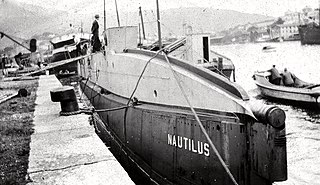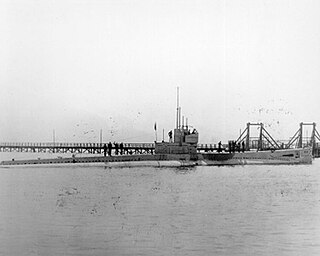
The Gato class of submarines were built for the United States Navy and launched in 1941–1943. Named after the lead ship of the class, USS Gato, they were the first mass-production U.S. submarine class of World War II.

USS O-12 (SS-73) was an O-class submarine of the United States Navy. These later O-boats, O-11 through O-16, were designed by Lake Torpedo Boat to different specifications than the earlier Electric Boat designs. They performed poorly as compared to the Electric Boat units, and are sometimes considered a separate class. The ship was launched in 1917 and entered service with the Navy in 1918 in the Panama Canal Zone.

USS G-1 (SS-19½) was the lead ship of her class of submarine of the United States Navy. While the four G-boats were nominally all of a class, they differed enough in significant details that they are sometimes considered to be four unique boats, each in a class by herself.

USS Cachalot (SC-4/SS-170), a United States Navy submarine and the lead ship of her class, known as the "V-boats", was the only ship of the United States Navy to be named for the sperm whale. Her keel was laid down by the Portsmouth Navy Yard. She was launched on 19 October 1933 as V-8 (SC-4) sponsored by Miss K. D. Kempff, and commissioned on 1 December 1933 with Lieutenant Commander Merril Comstock in command. Cachalot was the first submarine to have the Torpedo Data Computer, Arma Corporation's Mark 1, installed.

USS Cuttlefish (SC-5/SS-171), a Cachalot-class submarine and one of the "V-boats," was the second ship of the United States Navy to be named for the cuttlefish. Her keel was laid down by Electric Boat Company in Groton, Connecticut. She was launched on 21 November 1933 sponsored by Mrs. B. S. Bullard, and commissioned on 8 June 1934, Lieutenant Commander Charles W. "Gin" Styer in command. Cuttlefish was the first submarine built entirely at Electric Boat's facility in Groton, Connecticut; construction of previous Electric Boat designs had been subcontracted to other shipyards, notably Fore River Shipbuilding of Quincy, Massachusetts. Four Peruvian R-class submarines had previously been finished in Groton, using material from cancelled S-boats salvaged from Fore River.

USS Bergall (SS-320), a Balao-class submarine in commission from 1944 to 1958, was the first ship of the United States Navy to be named for the bergall, a small fish of the New England coast. During World War II she made five war patrols between 8 September 1944 and 17 June 1945, operating in the South China Sea, Java Sea, and Lombok Strait and north of the Malay Barrier. During these patrols she sank two Japanese merchant ships totaling 14,710 gross register tons and one 740-displacement ton Imperial Japanese Navy frigate. She also damaged the Japanese heavy cruiser Myōkō, which was never repaired.

USS E-1 (SS-24) was an E-class submarine of the United States Navy. Originally named Skipjack, the boat was launched on 27 May 1911 by the Fore River Shipyard, Quincy, Massachusetts; sponsored by Mrs. D. R. Battles; renamed E-1 on 17 November 1911; and commissioned on 14 February 1912, Lieutenant Chester W. Nimitz in command. She was the first American submarine to be powered by diesel engines.

The United States' S-class submarines, often simply called S-boats, were the first class of submarines with a significant number built to United States Navy designs. They made up the bulk of the USN submarine service in the interwar years and could be found in every theater of operations. While not considered fleet submarines, they were the first submarines in the USN designed for open ocean, blue water operations. All previous submarines had been intended for harbor or coastal defense. These boats were intended to have greater speed and range than previous classes, with improved habitability and greater armament.

USS S-48 (SS-159) was the first submarine in the fourth group of S-class submarines of the United States Navy.

USS R-21 (SS-98) was an R-class coastal and harbor defense submarine of the United States Navy. Her keel was laid down on 19 April 1917 by the Lake Torpedo Boat Company in Bridgeport, Connecticut; the R-boats built by Lake Torpedo Boat are sometimes considered a separate class from those built by Fore River Shipbuilding and Union Iron Works. She was launched on 10 July 1918 sponsored by Mrs. Dallas C. Laizure and commissioned on 17 June 1919.

USS K-5 (SS-36) was a K-class submarine of the United States Navy. Her keel was laid down by the Fore River Shipbuilding Company in Quincy, Massachusetts, under a subcontract from the Electric Boat Company of Groton, Connecticut. She was launched on 17 March 1914 sponsored by Mrs. Warren G. Child, and commissioned on 22 August.

USS G-2 (SS-27) was a G-class submarine of the United States Navy. While the four G-boats were nominally all of a class, they differed enough in significant details that they are sometimes considered to be four unique boats, each in a class by herself. A Simon Lake design, G-2 was named Tuna when her keel was laid down on 20 October 1909 by Newport News Shipbuilding in Newport News, Virginia. She was the first ship of the United States Navy to be named for the tuna, a large, vigorous, spiny-finned fish highly esteemed for sport and food. She was renamed G-2 on 17 November 1911, launched on 10 January 1912 sponsored by Ms. Marjorie F. Miller, towed to the New York Navy Yard after the termination of the Lake contract on 7 November 1913 where she was completed, and placed in reduced commission on 1 December 1913.

USS G-3 (SS-31) was a G-class submarine of the United States Navy. While the four G-boats were nominally all of a class, they differed enough in significant details that they are sometimes considered to be four unique boats, each in a class by herself. G-3 was named Turbot when her keel was laid down on 30 March 1911 by the Lake Torpedo Boat Company in Bridgeport, Connecticut, making her the first ship of the United States Navy to be named for the turbot, a large, brown and white flatfish, valued as a food. She was renamed G-3 on 17 November 1911, transferred to the New York Navy Yard for completion on 17 November 1913 following the cancellation of the Lake contract, launched on 27 December 1913, and commissioned on 22 March 1915. Unlike the other three boats of the G-class, G-3 had diesel engines.

Gymnote was one of the world's first all-electric submarines and the first functional submarine equipped with torpedoes.

HMS Swordfish was an experimental submarine built for the Royal Navy before the First World War to meet the Navy's goal of an "overseas" submarine capable of 20 knots on the surface. Diesel engines of the period were unreliable and not very powerful so steam turbines were proposed instead to meet the RN's requirement. Swordfish proved to be slower than designed and unstable while surfacing, and consequently she was modified as an anti-submarine patrol vessel in 1917. She was paid off before the end of the war and sold for scrapping in 1922.
The G-class submarines were a class of four United States Navy submarines. While the four G boats were nominally all of a class, they differed enough in significant details that they are sometimes considered to be four unique boats, each in a class by herself. They were the result of agitation for competition in submarine design; all previous US submarines were designed by Electric Boat. G-1, G-2, and G-3 were designed by Simon Lake of the Lake Torpedo Boat Company, while G-4 was designed by American Laurenti. G-1 and G-2 were built by Newport News, G-3 by Lake, and G-4 by Cramp.

SM U-21 or U-XXI was a U-20-class submarine or U-boat built for and operated by the Austro-Hungarian Navy during the First World War. The design for U-21 was based on submarines of the Royal Danish Navy's Havmanden class, and was largely obsolete by the beginning of the war.
USS Nina was a United States Navy steamer commissioned in 1866. She served in a variety of roles—as a tug, torpedo boat, torpedo boat tender, salvage ship, supply ship, and submarine tender—before she sank in a storm in 1910.
The Hrabri class consisted of two submarines built for the Kingdom of Serbs, Croats and Slovenes – Yugoslavia from 1929 on – by Vickers-Armstrong in the United Kingdom. Launched in 1927, the boats were named Hrabri (Brave) and Nebojša (Fearless). Their design was based on that of the British L-class submarine of World War I, and they were built using parts from L-class submarines that were never completed. The Hrabri-class were the first submarines to serve in the Royal Yugoslav Navy (KM), and after extensive sea trials and testing they sailed from the UK to the Adriatic coast of Yugoslavia, arriving in April 1928. They were armed with six bow-mounted 533 mm (21 in) torpedo tubes, two 102 mm (4 in) deck guns, one QF 2-pounder L/39 anti-aircraft gun and two machine guns. Their maximum diving depth was restricted to 55 metres (180 ft) by Yugoslav naval regulations.
Nebojša was the second of the Hrabri-class submarines; built for the Kingdom of Serbs, Croats and Slovenes– Yugoslavia by the Vickers-Armstrong Naval Yard in the United Kingdom. Launched in 1927, her design was based on the British L-class submarine of World War I, and was built using parts from an L-class submarine that was never completed. The Hrabri-class were the first submarines to serve in the Royal Yugoslav Navy (KM), and after extensive sea trials and testing Nebojša sailed from the UK to the Adriatic coast of Yugoslavia, arriving in April 1928. The submarine was armed with six bow-mounted 533 mm (21 in) torpedo tubes, two 102 mm (4 in) deck guns, one QF 2-pounder L/39 anti-aircraft gun and two machine guns. Its maximum diving depth was restricted to 55 metres (180 ft) by Yugoslav naval regulations.
















